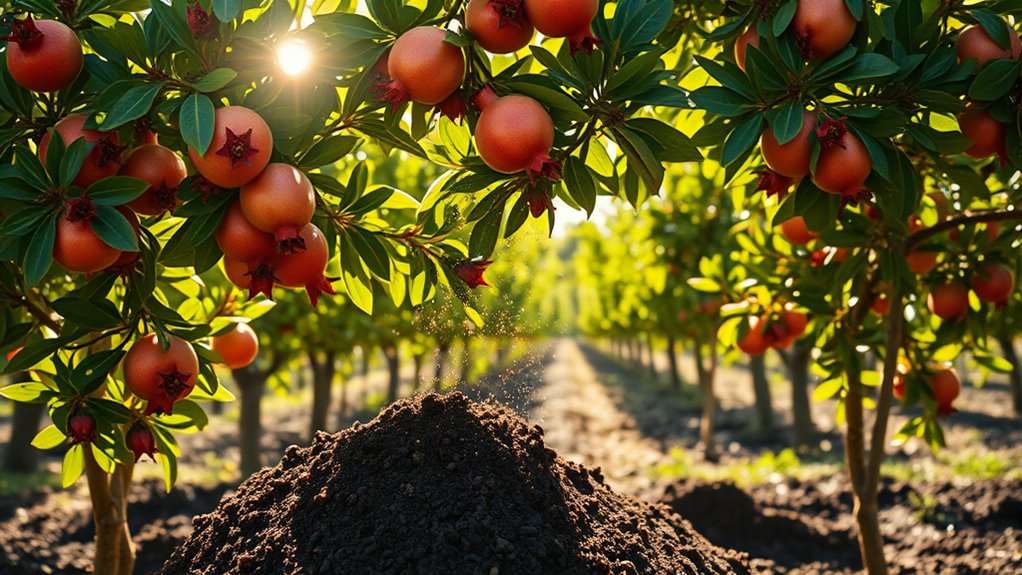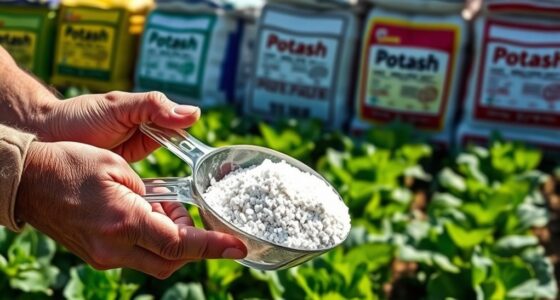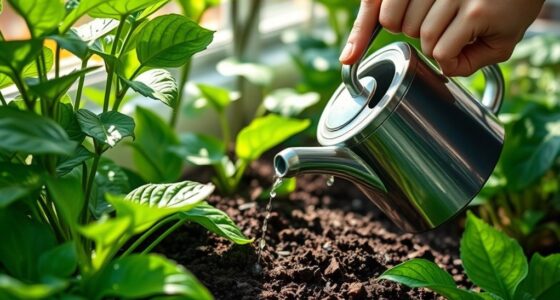To grow soft-seeded pomegranates successfully, fertilize in early spring and mid-summer with a balanced mix of nitrogen, phosphorus, and potassium, adjusting based on soil tests. Make certain your soil drains well and is rich in organic matter, and use mulch to retain moisture. Regular pruning improves airflow and nutrient access. Pay attention to your tree’s health and make nutrient adjustments as needed. Keep going for detailed guidance on nurturing healthy, productive pomegranates.
Key Takeaways
- Fertilize in early spring and mid-summer with balanced nutrients tailored for pomegranates, avoiding over-fertilization.
- Use organic matter and compost to improve soil drainage and nutrient content, especially in sandy or clay soils.
- Ensure proper watering habits—deep and infrequent—to prevent leaching and support healthy growth.
- Prune regularly to remove damaged branches, improve air circulation, and promote even fruit development.
- Monitor for nutrient deficiencies and adjust fertilization based on leaf color and overall tree health.

Growing soft-seeded pomegranates can be a rewarding experience, but it requires proper fertilization and care to guarantee healthy fruit development. When you’re starting out, focus on understanding the tree’s nutritional needs and providing the right balance of nutrients at each growth stage. Pomegranates thrive with a mix of macronutrients—nitrogen, phosphorus, and potassium—and micronutrients like magnesium, iron, and zinc. You’ll want to select a balanced fertilizer formulated for fruit trees or specifically for pomegranates, applying it at recommended rates and intervals. Typically, you should fertilize in early spring before new growth begins, then again in mid-summer, and possibly in late summer if the tree shows signs of nutrient deficiency. Avoid over-fertilizing, as this can lead to excessive vegetative growth at the expense of fruit quality, or cause salt buildup that damages roots.
Fertilize pomegranates in early spring, mid-summer, and late summer with balanced nutrients for healthy fruit growth.
As you care for your pomegranate tree, pay attention to soil health. Well-draining soil rich in organic matter supports healthy root development. If your soil is sandy or clay-heavy, amend it with compost or other organic amendments to improve fertility and drainage. Mulching around the base of the tree helps retain soil moisture, regulate temperature, and adds organic matter as it decomposes. Keep an eye on watering habits—pomegranates prefer deep, infrequent watering rather than frequent shallow watering, which encourages deep root growth and resilience during dry spells. Additionally, incorporating soil testing can help you determine precise nutrient levels to tailor your fertilization plan more effectively. Proper watering practices also prevent nutrient leaching, ensuring that the roots retain essential nutrients. Using organic fertilizers can also reduce the risk of soil contamination and promote healthier microbial activity in the soil.
Proper pruning also plays a crucial role in ensuring good fruit production and ease of fertilization. Remove any dead, damaged, or crossing branches to improve air circulation and sunlight penetration. Thin out crowded branches to promote even growth and make it easier for nutrients to reach all parts of the tree. When your tree is young, pruning helps establish a strong structure, but as it matures, regular maintenance keeps the canopy open and healthy. An understanding of soil composition can help you select appropriate amendments for optimal growth conditions.
Additionally, selecting the right filtration system for your watering setup can prevent nutrient runoff and ensure the proper absorption of fertilizers. Finally, monitor your tree regularly for signs of nutrient deficiencies or pests. Yellowing leaves might indicate a nitrogen deficiency, while poor fruit development could signal other issues. Address problems promptly by adjusting your fertilization schedule or applying organic pest controls. Consistent care, balanced fertilization, and attentive pruning will help you grow vibrant, healthy soft-seeded pomegranates. With patience and proper management, you’ll enjoy bountiful harvests of flavorful, soft-seeded fruits that are a delight to eat.
Frequently Asked Questions
What Are Common Pests Affecting Soft-Seeded Pomegranates?
You should be aware that common pests can threaten soft-seeded pomegranates. Aphids, which suck sap and weaken plants, are frequent nuisances. Whiteflies can also appear, spreading diseases and reducing fruit quality. Scale insects attach themselves to stems and leaves, causing damage. Additionally, fruit flies are attracted to ripe fruit, leading to infestations. Regular monitoring and integrated pest management help keep these pests under control, ensuring healthy, vibrant pomegranates.
How Do Climate Changes Impact Pomegranate Growth?
Climate changes are like shifting winds that can steer your pomegranate dreams off course. Warmer temperatures may extend growing seasons but also risk drought stress, while unexpected frosts can freeze your hopes in their tracks. You’ll need to adapt by selecting resilient varieties, adjusting watering schedules, and protecting blossoms. Embracing these changes helps your pomegranates flourish despite nature’s unpredictable temper, turning challenges into opportunities for a bountiful harvest.
Can Pomegranates Be Grown in Containers Successfully?
Yes, you can grow pomegranates successfully in containers. Choose a large pot with drainage holes, use well-draining soil, and place it where it gets plenty of sunlight. Water regularly, but avoid overwatering, and fertilize during the growing season. Container growing makes it easier to control the environment and protect your plant from extreme weather, giving you a healthy, productive pomegranate shrub right at home.
What Are Signs of Nutrient Deficiencies in Pomegranates?
Did you know that over 60% of pomegranate growers report nutrient deficiencies affecting fruit quality? You’ll notice leaf yellowing, stunted growth, or premature leaf drop as signs of deficiencies. If leaves turn pale or develop spots, it’s a clue you need to verify your fertilization routine. Keep an eye on your plant’s overall vigor, and address deficiencies promptly to ensure healthy, abundant fruit production.
How Long Does It Take for Pomegranates to Bear Fruit?
You can expect your pomegranate tree to bear fruit in about 2 to 3 years if you plant a young tree. If you start from seeds, it may take 4 to 6 years before you see fruit. Factors like climate, soil quality, and proper care influence this timeline. With patience and consistent care, your pomegranate will eventually produce delicious, juicy fruit for you to enjoy.
Conclusion
Just as the ancient pomegranate symbolizes fertility and abundance, nurturing your soft-seeded pomegranate with proper fertilization and care unleash its full potential. Remember, every seed you plant is a promise of future growth—patience and attention turn promise into fruit. Embrace the journey, knowing that like the mythic tree, your efforts will blossom into a bounty worth the wait. With dedication, you cultivate not just a crop, but a legacy of abundance.









